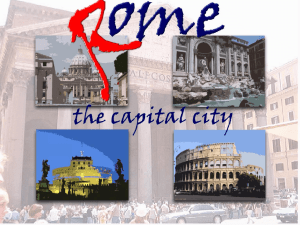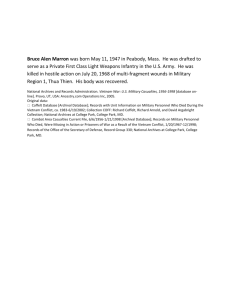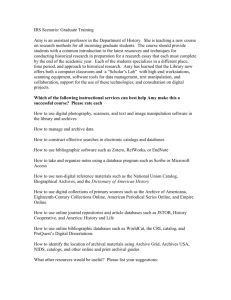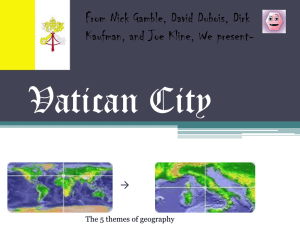LBSC670 Term Paper
advertisement
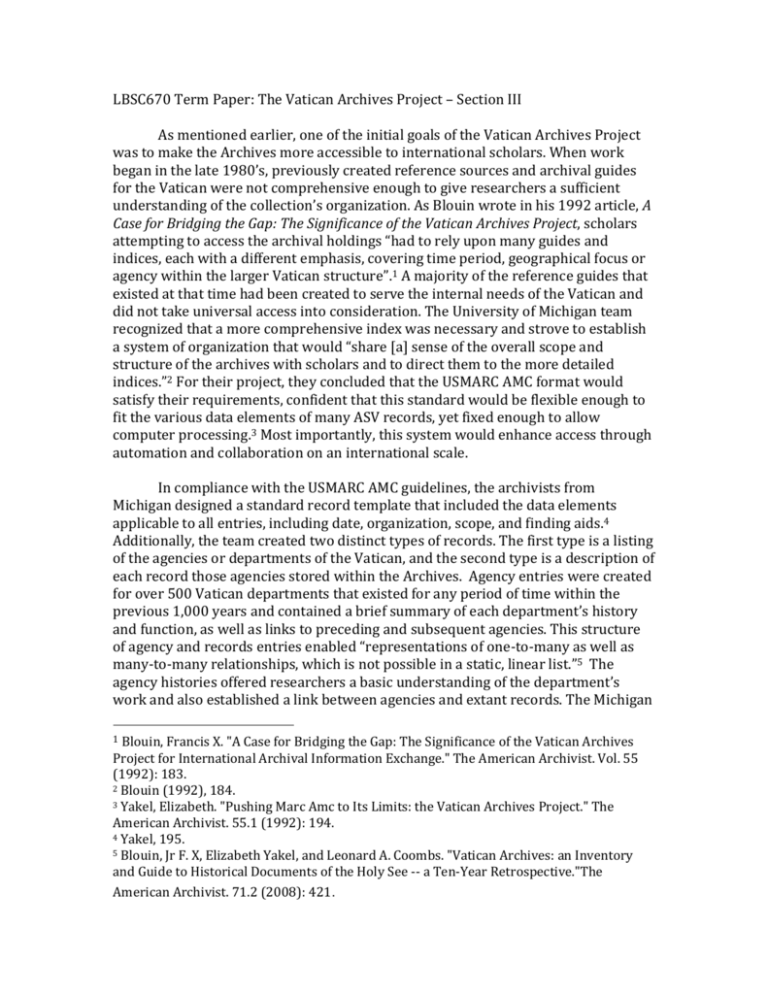
LBSC670 Term Paper: The Vatican Archives Project – Section III As mentioned earlier, one of the initial goals of the Vatican Archives Project was to make the Archives more accessible to international scholars. When work began in the late 1980’s, previously created reference sources and archival guides for the Vatican were not comprehensive enough to give researchers a sufficient understanding of the collection’s organization. As Blouin wrote in his 1992 article, A Case for Bridging the Gap: The Significance of the Vatican Archives Project, scholars attempting to access the archival holdings “had to rely upon many guides and indices, each with a different emphasis, covering time period, geographical focus or agency within the larger Vatican structure”.1 A majority of the reference guides that existed at that time had been created to serve the internal needs of the Vatican and did not take universal access into consideration. The University of Michigan team recognized that a more comprehensive index was necessary and strove to establish a system of organization that would “share [a] sense of the overall scope and structure of the archives with scholars and to direct them to the more detailed indices.”2 For their project, they concluded that the USMARC AMC format would satisfy their requirements, confident that this standard would be flexible enough to fit the various data elements of many ASV records, yet fixed enough to allow computer processing.3 Most importantly, this system would enhance access through automation and collaboration on an international scale. In compliance with the USMARC AMC guidelines, the archivists from Michigan designed a standard record template that included the data elements applicable to all entries, including date, organization, scope, and finding aids.4 Additionally, the team created two distinct types of records. The first type is a listing of the agencies or departments of the Vatican, and the second type is a description of each record those agencies stored within the Archives. Agency entries were created for over 500 Vatican departments that existed for any period of time within the previous 1,000 years and contained a brief summary of each department’s history and function, as well as links to preceding and subsequent agencies. This structure of agency and records entries enabled “representations of one-to-many as well as many-to-many relationships, which is not possible in a static, linear list.”5 The agency histories offered researchers a basic understanding of the department’s work and also established a link between agencies and extant records. The Michigan 1 Blouin, Francis X. "A Case for Bridging the Gap: The Significance of the Vatican Archives Project for International Archival Information Exchange." The American Archivist. Vol. 55 (1992): 183. 2 Blouin (1992), 184. 3 Yakel, Elizabeth. "Pushing Marc Amc to Its Limits: the Vatican Archives Project." The American Archivist. 55.1 (1992): 194. 4 Yakel, 195. 5 Blouin, Jr F. X, Elizabeth Yakel, and Leonard A. Coombs. "Vatican Archives: an Inventory and Guide to Historical Documents of the Holy See -- a Ten-Year Retrospective."The American Archivist. 71.2 (2008): 421. team listed the record groups by agency name, allowing for scholars to easily realize the scope and quantity of surviving records for each particular department, or conversely, the lack of surviving records. 6 Perhaps the greatest challenge the team from Michigan faced was the realization that the Vatican Archives contained only a small fraction of the papacy’s archival holdings; additional documents were spread across the continent. Thus, a secondary goal of the Michigan Project at its onset was to describe all archival materials produced by the Holy See, not only those present in the ASV, but those kept at other locations in- and outside of the Vatican as well. Fortunately, the USMARC AMC format easily allowed for the database to include those archival series that were kept in repositories separate from the Vatican using the location field (#851) to identify their physical location while maintaining the Vatican as the agency of origin. Certain historical events affected the contents of the ASV and littered its collection across Western Europe. The unification of Italy in 1870, for instance, resulted in numerous records being transferred from the Vatican to the Archivio di Stato di Roma. Similarly, the Napoleonic Wars led to several document series being relocated to The French Archives Nationales and the Bibliothque Nationale in Paris. The Vatican Archives Project team was able to enter information for these, and similar collections, in USMARC AMC format, into the database and successfully link the collections of multiple archives. The Vatican Archives Project was the first attempt by professionals to apply USMARC AMC to a major European archive and demonstrated the advantages of a uniform format for exchanging information on a large scale, considering the number of patrons who sought to utilize the collection. The Vatican Archives served as an ideal collection to attempt to organize according to this standard due to the fact that all articles within it were created by an institution with a generally stable and consistent government structure.7 The Michigan team believed that there was an incredible advantage to the machine-readable format of their records because, with its flexibility, it facilitated the exchange of information on an international scale. 8 Evaluating how the team expanded on certain fields within records in order to facilitate scholarly research exemplifies of the format’s adaptability. The “Scope and Content” area (Field #520), for instance, not only describes the item according to traditional archival categories, but “also infuses [the] descriptions with perspectives drawn from the scholarly use of the series”.9 Similarly, the Michigan team created extensive and detailed finding aids for each series. They “noted other guides that described the series, identified both current and retired indici, and described how they could best be used.”10 Enhancing the records in this way encouraged researchers to make connections between ecclesiastical information and other Blouin (1992), 184. Blouin (1992), 187. 8 Blouin (1992), 188. 9 Blouin (1992), 189. 10 Blouin (2008), 424. 6 7 disciplines (art history, politics, etc.) and also directed the researcher to related works for additional information. Constructing a digital access system differed significantly from creating a traditional printed guide because information technology allowed for additional accessibility options. The online database built by the University of Michigan team was designed so that it would facilitate incremental updates, permit researchers to retrieve information more precisely, and create interoperability across institutions; all of which was impossible in linear, printed guides.11 The MARC format was, in the late 1980’s, also used by the online public access catalog (OPAC) in the Vatican Library, as well as by the Research Libraries Group Research Library Information Network (RLIN). The Michigan archivists intended to upload their MARC records into the Vatican online catalog, believing their work would serve as a baseline for a dynamic database that could be updated and edited as needed by ASV staff. Additionally, they planned to add their records to the RLIN database, where they could serve to unify the diverse holdings of the ASV as well as link the ASV collection to others at institutions throughout Europe. Unfortunately, the Michigan team’s vision for creating a dynamic access system that encouraged international scholarly research has not yet been fully realized. Due largely to administrative changes and political shifts within the ASV, the results of the archivists efforts were never added to the Vatican Library’s OPAC, and although the records were included in the RLIN database, when RLIN merged into the OCLC WorldCat, the links between agency histories and records descriptions became invalid as they were designed specifically for the RLIN platform.12 In recent years, the only descriptive activity to occur that could be compared to the efforts of the Michigan Project is the ASV Web. This site, a subsection of the general website of the Holy See, is the most frequently used webbased access system for the Archives and provides a list of specific fonds and series within the archives, detailing a title, location, list of available finding aids, and identifying an agency of origin. This technique reflects a traditional approach to understanding and organizing the Vatican’s collection. The ASV records do not elaborate on any cited finding aids, in terms of their coverage, perspective, or limitations – which was a key advantage of the Michigan Project’s approach.13 Both the omission of explanatory contextual information in the agency histories and the scope-and-content notes, as well as the lack of any analytical work on the finding aids significantly diminish the value of the ASV website’s system. The AVS site treats the records in a traditional, linear fashion, with its “narrow emphasis on a limited number of diplomatic-based categories of description with little explanation for the user.”14 Overall, the current web presence of the ASV indicates that little progress Blouin (2008), 414. Blouin (2008), 432. 13 Blouin (2008), 419. 14 Blouin (2008), 425. 11 12 has been made in utilizing the potential of information technology in explicating the complexities of these archives.15 In regards to the Michigan team’s goal of creating a database that recognizes the even though some documents are located outside of Vatican City, they are still essentially part of the Vatican Archives, the ASV website is found wanting as it does not list significant series of papal documentation, nor does it reference any other repositories. There are still important archival materials stored in archives independent of the ASV; many congregations, for instance, maintain their own collections and there is a significant amount of material housed in the archives of Trinity College of Dublin. Due to the fact that the ASV focuses solely on its own collections, it fails to connect itself to the broader collection of documents that relate to the Holy See. The Michigan team believed that although the entire body of documents would most likely never be contained in one location, a broad archival record system, such as the one they conceived, would allow for a virtual unification of all relevant archival holdings. The work of the archivists from the University of Michigan produced a comprehensive database of the Vatican holdings at the time of its completion, however, it now faces sustainability issues. Somewhat ironically, The Vatican Archives: An Inventory and Guide to Historical Documents of the Holy See is, at present, the lasting legacy of the project due to the stagnation of the online database. As noted in its introduction, the Inventory and Guide is essentially a printout of the database as it existed in 1996.16 However, it must be understood that the database still has the potential for improvement, and thus, relevance to scholars. The Vatican Archives Project created a fundamental structure that has proven to be both adaptable and correctable and indeed, the existing database records have the capacity to be revised, reconfigured, enhanced, and transferred to newer systems. The database was constructed to allow for gradual information integration and exchange and with the hopes of eliminating the need for rekeying of the records contained within. Perhaps surprisingly, since the release of the Michigan Project data on RLIN in 1992 and the publication of the printed guide in 1998, new technology has not been used to further facilitate access to the Archives. The leaders of the Michigan team assert that the ASV could greatly improve its current website by using scanning technology to produce digital representations of indici which could be linked to the fonds listing. It would be equally beneficial to scholars if the ASV were to create and maintain a comprehensive bibliography of the works based on the fonds of the ASV, which would allow more efficient scholarly access and searching.17 Blouin (2008), 413. Blouin, Francis X. Vatican Archives: An Inventory and Guide to Historical Documents of the Holy See. New York: Oxford University Press, 1998. 17 Blouin (2008), 429. 15 16 Since the 1960’s, the Vatican Archives have issues bibliographies, structured by fond, of works based on ASV holdings. By simply scanning these entries and linking to descriptions of the appropriate fonds, the ASV web could give researchers an interactive way to see the prior uses of particular fonds. Similarly, Web 2.0 social networking technologies could be used to build a collaborative community of researchers and archivists by allowing users to annotate, comment on, and tag their findings. Scholarly commentary and tagging would provide additional access methods as well as present further archival information. Other new technologies that could be beneficial to this project are the Encoded Archival Description because in enables the exchange of data about archival finding aids, and applications such as Google Notebook and Zotero, which assist scholars in online not taking and capturing citation information.18 New, more modern, technological tools and techniques would even allow for adherence to the ASV Web’s fond-based method while still enabling a better understanding of the context. Overall, emerging technologies could provide access methods to international scholars that the Michigan team would not have been able to imagine when they began their work more then twenty years ago; however, because they chose to structure their data according to such a distinctly flexible standard, it could be quite easily transitioned into newer systems that would enhance access, search, and discovery. Ultimately, the Michigan Project and its subsequent publications should not be considered the final word on, or a failed attempt to organize, the Vatican archival holdings but rather the first step in a construction of a database that would serve as a comprehensive guide to the entire body of Holy See archives. Any online access system for Vatican archival holdings would need to be a sustainable descriptive program in which information in standard data structures could be migrated to new and more powerful platforms over time.19 In retrospect the Michigan Project broke new ground in an effort to create and more user-centered access point for the vast archival holdings of the Vatican and was proof positive for the benefits of a more universal archival standard. Additionally, the Michigan Project served as a conceptual precursor to numerous other archival guides including: the second edition of the International Standard Archival Authority Record for Corporate Bodies, Persons and Families (ISARR CPF, the Encoded Archival Context (EAC) and the International Standard on Activities/Functions of Corporate Bodies (ISAF).20 Blouin (2008), 431. Blouin (2008), 431. 20 Blouin (2008), 422-23. 18 19
